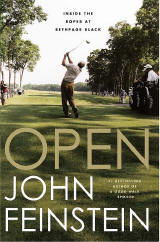Open: Inside the Ropes at Bethpage Black
I saw what Frank Rossi did during last year’s U.S. Open at Bethpage Black, but I didn’t know who he was.
Now I do, and I have John Feinstein to thank for it.
My buddy KC and I went to the Bethpage Open for the weekend rounds. As the first twosome of PGA Tour veteran John Daly and amateur Kevin Warrick rushed around the course on the last day, we worked our way over to the 18th hole’s grandstand after checking out the 15th and 3rd holes. Our chairs were five rows back from the front edge, looking out over the center of the green.
The stands quickly became full well shortly after we chose our intended seats for the rest of the day. It soon became obvious that the crowd wasn’t exactly the typical quiet bunch one usually thinks of when discussing the U.S. Open and the United States Golf Association.
For example, the spectators started applauding as soon as they began to notice a USGA staffer approaching the hole with the flagstick. He carefully placed it in the hole, and the crowd clapped and cheered. They roared even louder when he turned and waved to the stands, his mission complete.
That man was Frank Stossi, and Feinstein notes this little anecdote in recounting the action during the final round.
Feinstein’s primary theme for this fine book is that there’s a great story to be told about how a U.S. Open comes about, over and above who plays in it. He proves his point with his usual flair for gathering disparate facts and blending them into a coherent, compelling sports narrative.
In many respects, the 2002 Open was a typical example of the USGA’s primary championship, but in several ways this was a very special Open.
It was the first time that the championship (not “tournament,” we’re told repeatedly) was held on a course open to the public and owned by the public. USGA executive David Fay realized there are millions of avid golfers who will never set foot on the typical country club layouts on which the Open is held, and that under the right conditions, the nation’s Open should be held at a place where anyone can play.
Fortunately, Fay knew enough about Bethpage Black to be inspired to visit it in the 1990s. Despite the golf course’s fairly wretched condition at that point, Fay realized that the old A.W. Tillinghast design could be restored and provide a stern test of modern golf of the type for which the USGA is justly famous. It was a matter of convincing the USGA leadership, and then developing a good working relationship with the New York State government, the course owners.
Feinstein shows how Fay succeeded in achieving this goal, perhaps beyond Fay’s own expectations.
The Bethpage Open set several records, including the largest crowds, most volunteers, and the biggest sales at the huge merchandise tent, a major money-maker for the nonprofit lords of American golf. The state parks people and the thousands of golfers who played Bethpage jumped at the chance to show what kind of a gem their course could be for the best players in the world.
Feinstein gives his readers great character studies throughout the book of many of the key people responsible for these records, several of whom spent years preparing the place for this one special week.
One additional achievement stands out. Almost all of the players praised the course’s fairness, while recognizing it as one of the toughest layouts they’d ever faced. The inherent qualities of the Tillinghast design as restored by Rees Jones and the cooperative effort between the state and the USGA made it possible.
Feinstein doesn’t neglect the fact that the Open competition was the reason for all the hard work of preparing Bethpage for it. Anyone thinking that several hundred pages would be devoted to just the four days of play, however, would be greatly mistaken.
The sports writing Feinstein does so well about players like the eventual winner, Tiger Woods, as well as some of his favorites from A Good Walk Spoiled like Jeff Sluman and Paul Goydos, is well in evidence. Nevertheless, the real focus of this book is on the people who made this Open possible.
These folks deserve our thanks, and reading Feinstein’s book is a great way to show one’s appreciation. Now we know who they are, what they did, and why they should be so proud of their accomplishment.
Review Date: June 14, 2003


